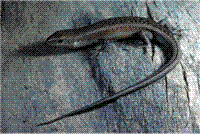Family
Scincidae (Skinks)
Genus
Carlia
Species
tetradactylaThreats/Control Methods - Regional
The reduction in habitat related to expansion of the urban area into the northern parts of the ACT will likely lead to a reduction in the already small population numbers of the Four-fingered Skink.
Threats/Control Methods - Local
Disturbance of habitat by domestic and feral animals, as well as the lack of good habitat in many garden areas means that local populations will possibly continue to decline.
Local/Urban Actions
In urban areas, better habitat for the lizard can be maintained in nature reserves and gardens by retaining leaf litter and dead wood at ground level.
Common name/s
Four-fingered Skink, Southern Rainbow Skink
Distinguishing Features
This skink has four fingers on its front limbs and five toes on the back limbs, with the limbs being quite long. It is primarily brown above, with a mixture of dark and light markings down the centre of the back. The belly is blue-green to grey and breeding males have a pair of conspicuous orange stripes down the side of the body. The lizard is larger than many similar skinks, growing to a maximum length of 15cm including tail.
Similar Species
The Common Dwarf Skink (Menetia greyii ) also has the same number digits on each limb, but it is considerably smaller than the Four-fingered Skink. The Common Dwarf Skink's limbs are also much shorter compared to its body.
Distribution
The Four-fingered Skink ranges from south-eastern Queensland, through eastern NSW and just into the northern edge of East Gippsland in Victoria. It occupies the warmer areas of the ACT, to the north and east of the territory.
Country of Origin
Australia
Survey Techniques
Pitfall trapping and hand searching can be used to locate the Four-fingered Skink in surveys.
Conservation (Pet/Pest) Status - National
Not listed under a threatened category in the EPBC Act 1999.
Conservation (Pet/Pest) Status - Regional
Not considered threatened in the ACT under the Nature Conservation Act 1980.
LSCCES Population
Uncommon.
Associated vegetation community
Dry sclerophyll forest and woodland.
Limiting Resources
Four-fingered Skink populations are limited by adequate areas of woodland. If canopy cover is more sparse, where trees have been cleared, then the lizard is much less common.
Breeding
The Four-fingered Skink has a low reproductive rate, with only two eggs laid each spring. The species can lay communally, with up to 25 eggs found in one nest. The eggs hatch after two months, with the hatchlings being vulnerable to predators.
Behaviour
The Four-fingered Skink is a diurnal and ground dwelling species. It usually shelters beneath ground debris, tussock grasses, logs and rocks.
Functional Group
Insectivore
Food Species
The species primarily feeds on small arthropods.
Predators
Various species of snakes predate on reptiles including the Four-fingered Skink.
Interesting Fact
The Four-fingered Skink is the only species of the Carlia genus which exists naturally in the ACT. Carlia species are well known as the Rainbow Skinks for the colourful markings of the breeding males.
References - (reader suitability of references, P=Primary teachers, S=Secondary students, T=Tertiary students and researchers)
Books:
Bennett, R. 1997. Reptiles & Frogs of the Australian Capital Territory, National Parks Association of the ACT, Woden. S, T
Swan, G., Shea, G. and Sadlier, R. 2004. A Field Guide to Reptiles of New South Wales, Second Edition, Reed New Holland, Sydney. S, T
Journal Articles:
Fischer, J., Lindenmayer, D. and Cowling, A. 2003. Habitat models for the four-fingered skink (Carlia tetradactyla) at the microhabitat and landscape scale. Wildlife Research, vol 30, no. 5, pp 495 - 504. T
Online Publications:
Greer, A.E. 2006. Encyclopedia of Australian Reptiles. Australian Museum Online, Version date: 7 August 2006. Thttp://www.amonline.net.au/herpetology/research/index.htm#encyclopedia [Last accessed 01/05/07]
Researcher: Ian Rayner

 Top
Top Top
Top